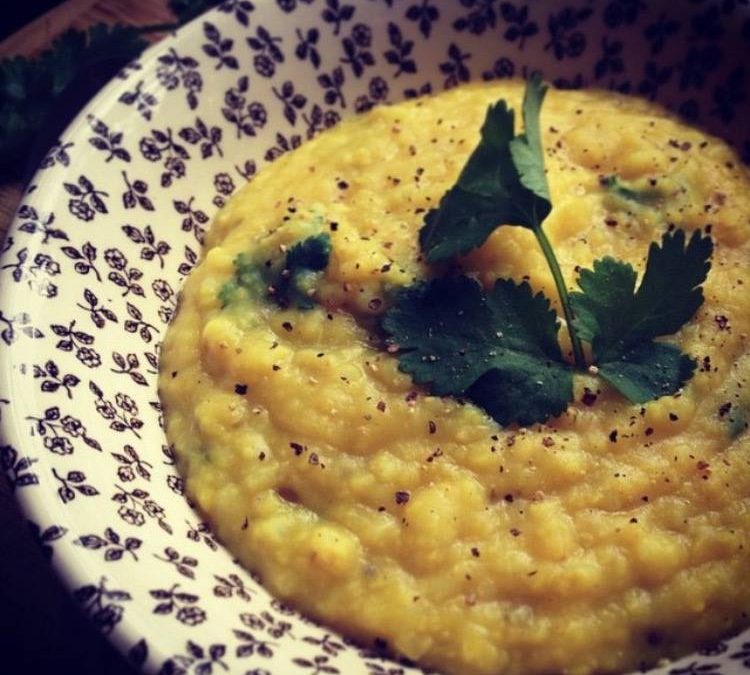For thousands of years, Kitchari has been a prized recipe used in the Ayurvedic cookbook due to its amazing healing benefits and detoxifying effects. The simple porridge like dish is made of cooked white rice and split yellow mung beans, in combination with spices and vegetables. The dish is used to nourish babies, the elderly, the sick, and the healthy in times of deep spiritual practice and cleansing. If you are in need of healing, look no further than a Kitchari cleanse!
The base is made of long grain basmati white rice and split yellow mung beans. You might ask, why white rice instead of brown? This is because white rice doesn’t contain the fibrous husk that coats brown rice. When detoxifying the body, it is important to provide it with food that is easiest to digest. While brown rice provides more nutrients, the husk makes it much harder to digest and can irritate the intestinal wall, causing gas and bloating. This is why white rice is preferred during cleansing. The second staple ingredient to this simple dish is split yellow mung beans. This legume is excellent for balancing vata, the dosha of ether and air that is seated in the colon. Like white rice, they have their husks naturally removed during the splitting process. Therefore, unlike other beans, split yellow mung beans are the only legume that will not produce any intestinal gas and bloating.
When these beans and rice are combined, they create a complete protein. The body needs ten essential amino acids from food sources in order to thrive. While animal proteins are complete and contain these ten essential amino acids, plant based foods need to be combined. This protein is important during a cleanse since it is essential for keeping blood sugars stable and the body burning fat. During many cleanses that involve fasting, juicing, or only eating raw foods; it is depriving the body of the nourishment it needs to survive. This puts a huge amount of stress on the body, so in response, the metabolism slows down, blood sugars are depleted, and the body begins to store fat. This is why many people become irritable, hungry, and tired when going through a fast. It backfires and the body ends up storing more fat in an emergency response to stress! This is the last thing we want when trying to cleanse the body of chemicals and toxins, which is why Kitchari is the perfect food for providing nourishment during a detox. When we eat split yellow mung beans and long grain basmati white rice together, we are providing our bodies with a complete protein that is easy to digest three times day, so there is no stress on the body and excess fat is burned off.
Kitchari also helps heal the gut by soothing the intestinal wall. As previously discussed in our articles on Gut Health, the digestive system is the center of our mental and physical well-being. Stress will irritate the intestinal wall and disrupt digestion, leading to a buildup of Ama, or toxins in the body. During a Kitchari cleanse, the body enters a mono-diet, which allows the digestive system to rest and heal while also providing the body with gentle nourishment. Kitchari has also been traditionally given to monks during times of deep spiritual practice because of it’s ability to help clear the mind and spirit. This is why Kitchari is the food of choice during Ayurveda’s deepest detox: Panchakarma.
Kitchari can be made with various combinations of spices and vegetables in order to suit your body’s constitution at the moment. Ghee (clarified butter) is also optional. During a Kitchari cleanse, however, it is recommended to use little or no Ghee. Here is a simple recipe for a Kitchari dish.
-1 cup of split yellow mung dahl beans
-1/2 cup of basmati white rice
-1 tbsp. of Ghee (unless cleansing)
-1 tbsp. of fresh ginger
-1 tsp. of black mustard seeds, cumin, and turmeric
-1/2 tsp. of coriander, fennel and fenugreek
-3 cloves and 3 bay leaves
-7 cups of water
-Fresh cilantro leaves
-Freshly chopped and steamed vegetables of your choice (unless cleansing)
First, wash the mung beans and rice until the water runs clear. Then, combine the spices in a large pot and dry roast them to enhance the flavor. After roasting the spices, add the Ghee and the beans/rice, stirring them all together to coat them with the spices. After stirring, add water and boil for 10 minutes. Then turn the heat on low and let it simmer for about 30 to 40 minutes, until the Kitchari become soft. Add the steamed vegetables and cilantro before serving and salt to taste.
Now you are set with a wonderful healing dish to make whenever you are sick, sad, in need of a cleanse, or craving some comfort food! This incredible meal is a staple in every Ayurvedic kitchen, and we hope it will be in yours too.
Many Blessings,
Santa Cruz Ayurveda
Resources:
Douillard, John. “What’s So Amazing About Kitchari?”. Lifespa.com. March 21st, 2013. Web. June 21st, 2017.
